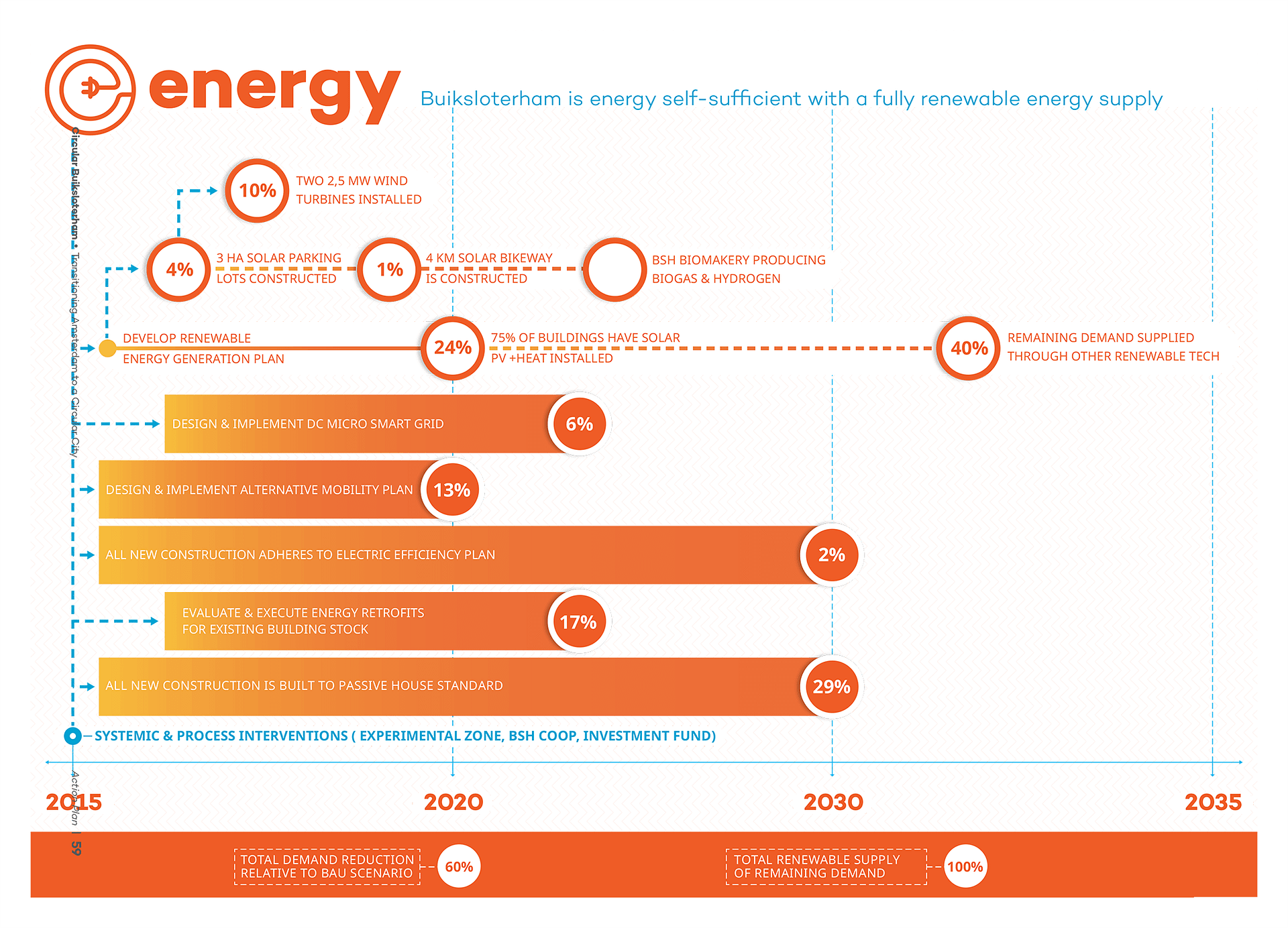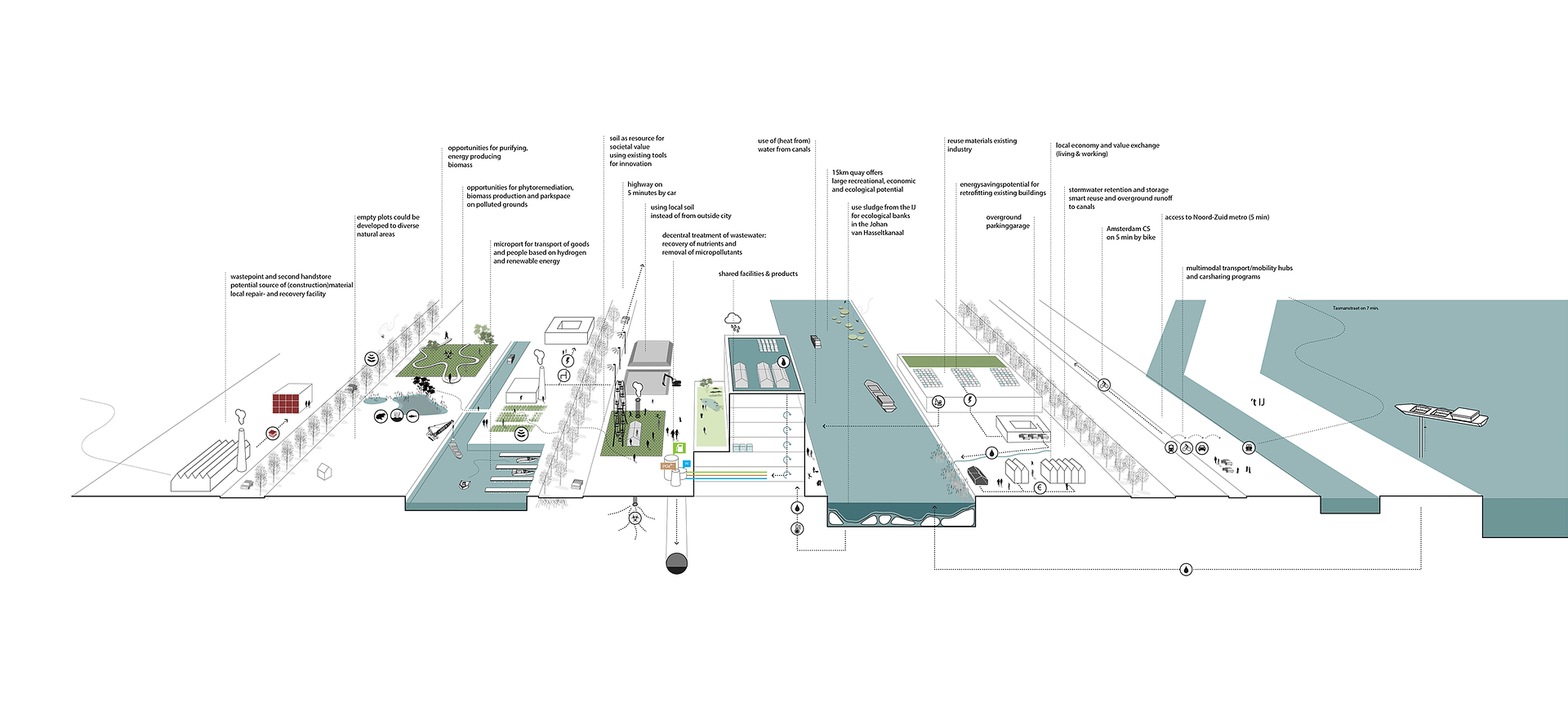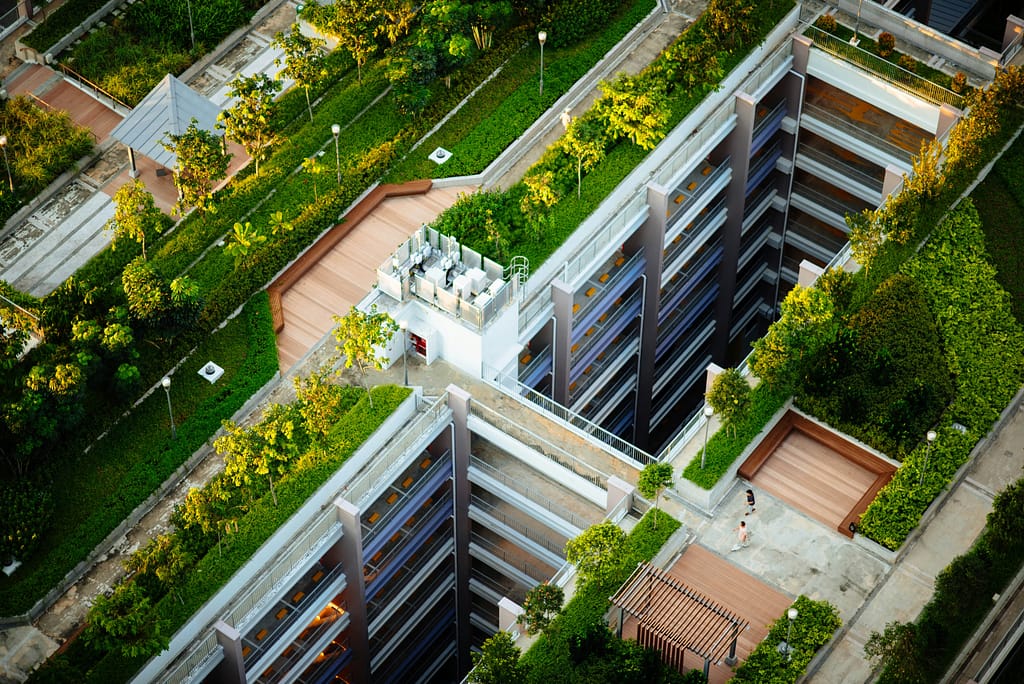Circular Buiksloterham
"You do not design a circular city. You allow it to rise."
For Buiksloterham, a 100 hectare post-industrial site in Amsterdam-North, we developed a vision, roadmap and action plan to transition to a fully circular neighborhood. Today, the neighbourhood is set to become a global example of circular urban development.
- Client: Waternet, De Alliantie and the City of Amsterdam (Dienst Ruimtelijke Ordening)
- Partners: DELVA Landscape Architects, Studio Nine Dots, Peter Dortwegt (New Energy Docks), Saskia Muller (Amsterdam Smart City), Frank Alsema (Neighborhood Coordinator)
Transforming cities is one of the biggest leverage points in moving towards a circular economy. Cities consume two thirds of global energy and 75% of global resources, are responsible for 70% of CO₂ emissions, yet cities cover only 3% of the globe. And they are predicted to grow. By 2050, the UN predicts that 68% of the global population will live in urban areas. Creating sustainable and circular cities is a priority. This starts one neighborhood at a time.
Buiksloterham is a typical post-industrial district, just a short ferry from the center of Amsterdam. Like many industrial areas, Buiksloterham contained heavy industries that left to low-wage countries in the 2nd half of the 20th century, leaving large abandoned areas on a centrally located and well accessible location. The area, shaped by a vast system of harbors, is now being completely redeveloped into a neighborhood for living and working. This created an opportunity for the city to create Amsterdam’s first circular urban development. To do so, they brought in Metabolic to create a vision and action plan.
Together with the City of Amsterdam, housing corporations, utility companies, and residents, Metabolic analyzed the area’s resource flows and developed a 20-year vision for holistic circularity in Buiksloterham. With local stakeholders, Metabolic developed a set of interventions for improving the current situation through waste minimization, high levels of source separation, and improved recycling techniques. These interventions were then translated into a roadmap and action plan. In 2015, the Circular Buiksloterham Manifesto was signed by more than 25 committed stakeholders, anchoring public support for follow-up studies and pilot projects, and influencing urban development within Amsterdam as a whole.

- Water will play a more prominent rule in the urban landscape of Buiksloterham in the future, both as a recreational and mobility feature.
- Around 6.500 people will live in Buiksloterham and around 8.000 additional people will work here once the development is completed. 30% of Buiksloterham is projected to be dedicated to social housing.
- Retail and commercial facilities will only be located around the Klaprozenweg.
- An extensive grid of main and side streets will be built with idea of increasing accessibility and dispersing traffic.
- By widening the public roads, more space is created for bicycles, which will heighten the demand for bike storage spaces. It is planned to create at least one bike parking per 25m2 housing.
- The municipality has projected to make the area more accessible by water for both recreational purposes and mobility.
- The municipality aims to facilitate the switching of different modes of transport (from public transport to individual sustainable transport like bikes, e-bikes and electric vehicles)
- Buiksloterham holds an opportunity of creating a continuous green link between the Klaprozenscheg and the rest of Amsterdam North.
The development of Buiksloterham as a living lab for circularity has led to a significant strengthening of the local economy and a transformation of what could previously have been deemed ‘unusable land’ into a thriving neighbourhood. Currently, Buiksloterham is undergoing transformation from an industrial area to a mixed living and working area. In 2013, the whole of Buiksloterham, an area of 100 hectares, totaled 252 residents. Once the redevelopment process envisioned by the city of Amsterdam is complete, it is projected that around 6500 people will live in Buiksloterham and an additional 8000 people will work in the area.
As a result of the sustainability tenders by the municipality, two unique projects have come forth. De Ceuvel, consisting of retrofitted houseboats placed on land, and Schoonschip, a newbuilt floating housing community. Aiming at setting a new pattern for urban development, both sites have high sustainability targets: 100% renewable electricity, heating and hot water, 100% water self sufficiency, 100% waste water management, 50-70% nutrient recovery, 10-30% food production on site for de Ceuvel and for Schoonschip these goals are even set higher. By integrating different resource flows and developing smart financial scenarios, both developments yield a high return on investment for the applied clean technologies and have become financially feasible for the communities.
In May 2020, our sister company Spectral joined the ATELIER project to turn Buiksloterham into a district that produces more green energy than it consumes. The smart microgrids of De Ceuvel, Schoonschip and Republica and others will be combined to form a district-wide energy generation, storage and trading network across Buikslotherham.
Buikslotherham’s smart energy and heating capabilities include more than 1 MWp of solar plants, smart heat pumps, (underground) heat storage, smart electric vehicle charging hubs, and both (30+) decentralized home batteries, as well as a (>1MWh) centralized community battery system. Spectral will implement their Local Energy Market platform within Buiksloterham, which will allow both residents and local businesses to trade renewable energy across the district. If a block of flats is generating more than it needs during working hours, a nearby business might be able to access that available green energy.
“The ATELIER project connects the different locations within Buiksloterham together into a Positive Energy District, to demonstrate how smart technologies can enable greater resilience and energy efficiency on a local level. With local communities cooperating to keep the grid in balance and enable maximal use of local sustainable energy.” – Frans Verspeek, Overall Project Coordinator ATELIER, City of Amsterdam
- Circular Buiksloterham: Designing post-industrial Amsterdam
- Buiksloterham in the news (CityScope)
- Metabolic pioneers urban and regional approaches for a circular economy
- Why cities and regions hold the key to accelerating the circular economy
- ATELIER: A global smart energy showcase for creating energy positive districts












“Buiksloterham is practically a “blank slate” that can “serve as both a test bed and catalyst for Amsterdam’s broader transition to becoming a circular, smart and biobased city.”
Cityscope
Director of Sustainable Cities & Regions
ANY QUESTIONS?
For more information about this project, please get in touch.








